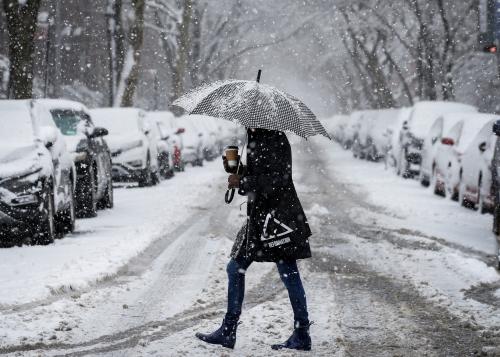The Bureau of Labor Statistics (BLS) employment report released last Friday shows that 227,000 new jobs were added in January 2017. In this blog post, I will put forward three alternative projections for job growth in January 2017, each of which was calculated using methodology outlined in my past research.
Producing the Alternative Seasonal Adjustment, the Seasonal and Weather Adjustment, and the Combined Alternative Seasonal and Weather Adjustment discussed in in this blog post relies on a replication of the BLS seasonal adjustment procedure. Once a year, the BLS updates its seasonal adjustment procedure—and that update was last week. Consequently, our usual alternate projections were delayed this month.
Calculating the Alternative Seasonal Adjustment
Monthly job gains and losses can indicate how the economy is doing once they are corrected to account for the pattern the BLS already expects in a process called seasonal adjustment. The approach for this seasonal adjustment that is presently used by the BLS puts very heavy weight on the current and last two years of data in assessing what are the typical patterns for each month.
In my 2013 paper “Unseasonal Seasonals?” I argue that a longer window should be used to estimate seasonal effects. I find that using a different seasonal filter, known as the 3×9 filter, produces better results and more accurate forecasts by emphasizing more years of data. The 3×9 filter spreads weight over the most recent six years in estimating seasonal patterns, which makes them more stable over time than the current BLS seasonal adjustment method.
To produce the Alternative Seasonal Adjustment, I calculate the month-over-month change in total nonfarm payrolls, seasonally adjusted by the 3×9 filter, for the most recent month, which you can see in table below. The corresponding data as published by the BLS are shown for comparison purposes.
According to the Alternative Seasonal Adjustment, the economy added 199,000 jobs in December, 28,000 less than the official BLS total of 227,000. Part of this is probably because in January 2016, the data were weak, and this pulled down the official seasonal factors.
Calculating the Seasonal and Weather Adjustment
In addition to seasonal effects, abnormal weather can also affect month-to-month fluctuations in job growth. In my 2015 paper “Weather-Adjusting Economic Data,” Michael Boldin and I implement a statistical methodology for adjusting employment data for the effects of deviations in weather from seasonal norms. This is distinct from seasonal adjustment, which only controls for the normal variation in weather across the year. We use several indicators of weather, including temperature and snowfall.
Temperatures in January were milder than normal, following a colder-than-normal December. This boosted job gains in the month. Controlling for weather yields a higher Seasonal and Weather Adjustment estimate of 192,000 job gains. We find that the cold weather raised employment by 35,000 jobs.
Combining the Alternative Seasonal and Weather Adjustments
Both my Alternative Seasonal Adjustment and our Weather Adjustment show lower job gains than reported by the BLS. One can indeed do the two adjustments jointly—both adjusting for weather effects and using a longer window. This is shown in the far-right column of the table labeled Combined Alternative Seasonal and Weather Adjustment.
Making both adjustments, the employment change in January was an increase of just 164,000 jobs. Note that this combined adjustment is close to, but not the same as, simply subtracting the weather effect from the alternative seasonal adjustment number.
After weather adjustment and using a more stable seasonal filter, the pace of jobs growth has been remarkably stable—at around 170,000 per month—for the last three months. This is a solid but not blistering pace of job growth. It is however well above the 80,000 per month pace that President John C. Williams of the San Francisco Fed views as sustainable.
| Thousands of jobs added | BLS Official | Alternative Seasonal Adjustment | Seasonal and Weather Adjustment | Weather Effect | Combined Alternative Seasonal and Weather Adjustment |
|---|---|---|---|---|---|
| 2017-January | 227 | 199 | 192 | +35 | 164 |
| 2016-December | 157 | 166 | 181 | -24 | 178 |
| 2016-November | 164 | 170 | 159 | +5 | 172 |
| 2016-October | 124 | 131 | 121 | +3 | 124 |
| 2016-September | 249 | 237 | 261 | -12 | 251 |
| 2016-August | 176 | 166 | 167 | +9 | 165 |
| 2016-July | 291 | 310 | 292 | -1 | 316 |
| 2016-June | 297 | 294 | 289 | +8 | 295 |
| 2016-May | 43 | 45 | 27 | +16 | 14 |
| 2016-April | 153 | 155 | 205 | -52 | 220 |
| 2016-March | 225 | 197 | 231 | -6 | 206 |
| 2016-February | 237 | 269 | 205 | +32 | 213 |
| 2016-January | 126 | 105 | 162 | -36 | 142 |
Note: Changes in previous months’ numbers reflect revisions to the underlying data.
Column labeled Alternative Seasonal Adjustment applies a longer window estimate of seasonal effects (see Wright 2013).
Column labeled Seasonal and Weather Adjustment includes seasonal and weather adjustments, where seasonal adjustments are estimated using the BLS window specifications (see Boldin & Wright 2015).
Column labeled Weather Effect is BLS Official number less the Seasonal and Weather Adjustment number.
Column labeled Combined Alternative Seasonal and Weather Adjustment includes seasonal and weather adjustments, where seasonal adjustments are estimated using a longer window estimate.
The author did not receive financial support from any firm or person for this article or from any firm or person with a financial or political interest in this article. He is currently not an officer, director, or board member of any organization with an interest in this article.







Commentary
January employment growth boosted by mild weather
February 6, 2017